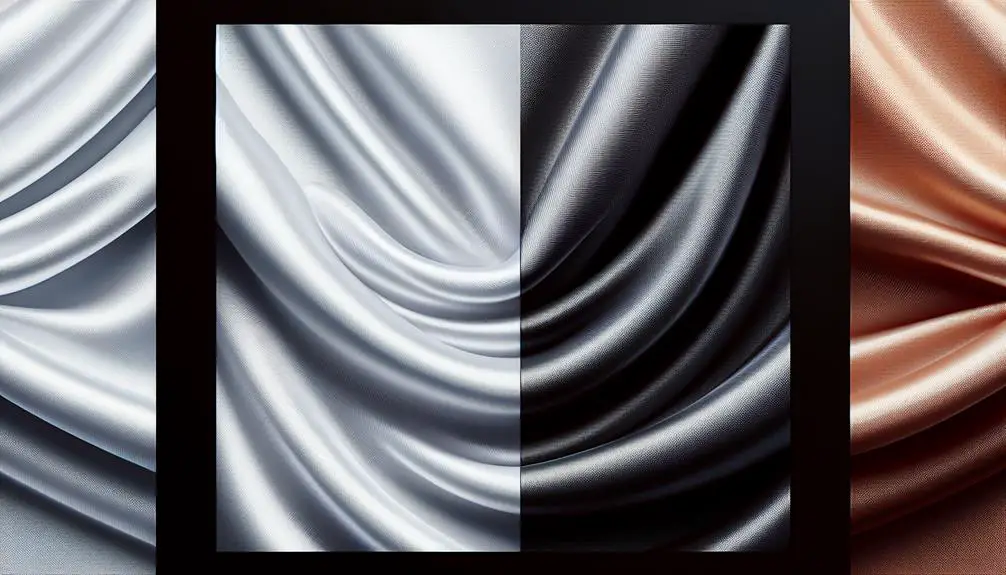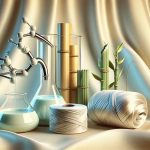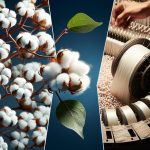I've always been curious about what makes rayon so similar to silk, beyond its obvious luster and smooth touch. It's fascinating how this semi-synthetic fabric, made from natural cellulose, can mimic silk's luxurious feel and elegant drape, all while being more wallet-friendly. Yet, it's not just about the aesthetics or cost; there's also the aspect of maintenance and how rayon stands up to wear and tear compared to its natural counterpart. But I can't help but wonder, does rayon truly hold up in the long run, and what does this mean for those of us looking for sustainable yet chic options? This question seems to open up a broader conversation about fashion, sustainability, and our choices.
Table of Contents
Key Takeaways
- Rayon is often compared to silk due to its smooth, shiny appearance and soft texture.
- It mimics silk's luxurious drape and silk-like sheen, making it a close alternative.
- Unlike silk, rayon is more affordable, making it accessible for various applications.
- Rayon offers similar comfort and softness to cotton but with a more lustrous finish.
- Despite its differences, rayon's semi-synthetic nature bridges the gap between natural fibers like silk and cotton.
Rayon Versus Silk
Rayon's often called 'artificial silk' because it's got that smooth, shiny look of silk without the hefty price tag. When I'm out shopping for something that feels luxurious but doesn't drain my wallet, rayon's my go-to fabric. It's soft and comfortable, making it perfect for everything from blouses to dresses. The thing about rayon that really stands out is how it manages to offer that silk-like sheen. It's pretty incredible how it mimics silk's elegant drape, yet you don't have to shell out nearly as much cash.
The affordability of rayon makes it a no-brainer for anyone looking to add a touch of class to their wardrobe without breaking the bank. I love that I can rock a sophisticated, silky look at a fraction of the cost. It's like having your cake and eating it too. For anyone obsessed with the soft, luxurious feel of fabric but sticking to a budget, rayon is a dream come true. Seriously, finding something that's both affordable and feels amazing against the skin? That's the sweet spot, and rayon hits it every time.
Understanding Rayon's Properties
To truly appreciate what sets rayon apart, it's essential to dive into its unique properties. First off, let's talk cellulose. Rayon's a semi-synthetic fiber, born from natural cellulose, which is a fancy way of saying it starts with stuff from plants. This is where it gets its edge, blending the best of both worlds: the natural and the engineered.
Rayon fabric nails the look and feel of silk, but here's the kicker – it's way more wallet-friendly and versatile. Think of it as the undercover agent in the fabric world, slipping into roles that range from luxury to everyday wear without missing a beat. Its ability to mimic silk's soft, smooth texture and elegant drape makes it a go-to for those flowy, eye-catching pieces we all love.
But it doesn't stop at just looking good. Rayon's drape and sheen add a touch of luxury that's hard to beat, making it an awesome alternative to cotton when you're aiming for that upscale vibe without draining your bank account. So, in a nutshell, rayon's a champ at bridging the gap between natural fibers and the need for affordable, stylish options.
Rayon and Cotton Comparison
When comparing rayon and cotton, it's clear they both offer a comfy vibe, but they come from different starting blocks. Cotton's a natural buddy, straight from the plant, while rayon's a bit more complex, being a semi-synthetic fiber made from regenerated cellulose, like wood pulp.
Both have their unique charms, but here's the lowdown on why you might pick one over the other:
- Softness and Comfort: Both rayon fabrics and cotton fabric are winners when it comes to softness and feeling good against your skin. It's a tie in the comfort department.
- Durability and Care: Cotton takes the crown for durability, especially when dry. However, rayon can be a little more high maintenance, losing some of its strength when wet. So, if you're looking for something that'll hold up better over time, cotton's your go-to.
- Moisture Management: Here's where rayon edges ahead. Being highly absorbent, more so than cotton, rayon fabrics are fantastic for those super sweaty days, keeping you cooler and drier.
Both fabrics have their moments to shine, depending on what you're after. Whether it's the durability and natural origins of cotton or the superior absorbency and comfort of rayon, there's a fabric out there that's just right for you.
The Affordability of Rayon
One of the biggest perks of rayon is how it keeps your wallet happy, offering that luxe vibe without the steep price tag of silk. Honestly, when I first discovered rayon, I was blown away by its affordability compared to natural fabrics like silk. It's like getting the look and feel of luxury without having to eat ramen for a month to afford it.
The thing is, rayon's production process is what makes it such a cost-effective alternative. You're getting that luxurious appearance, but at a fraction of the cost. And who doesn't love a good bargain that doesn't compromise on quality or aesthetics? This price point makes rayon a super popular choice, not just for fashion enthusiasts like myself but for a wide range of clothing and textile applications.
What's more, its affordability brings rayon to a broader market. You don't need to have deep pockets to enjoy its benefits. Whether you're sprucing up your wardrobe or adding a touch of class to your home decor, rayon's got you covered. It's proof that you can have that luxurious look and feel without breaking the bank.
Maintenance and Care Tips
So, I've got my new rayon shirt and I'm thinking, 'How do I keep this looking good?'
Turns out, washing it right is key – hand wash or dry clean only, folks.
Then, when it's time to dry and iron, you gotta be gentle, like using low heat and avoiding any wringing action.
Washing Rayon Properly
To keep your rayon clothes looking their best, you'll want to wash them in cold water on a gentle cycle. Rayon's a bit finicky, so you gotta treat it right to prevent any mishaps like shrinking or losing its shape. Here's my go-to list for washing rayon properly:
- Always opt for a gentle cycle – It's easy on the fabric and prevents damage.
- Use a mild detergent – Harsh chemicals are a no-go. Pick something designed for delicates.
- Lay it flat to air-dry – Skip the wringer and let it dry naturally to keep its shape.
Drying and Ironing Rayon
After washing your rayon garments, drying and ironing them correctly is crucial to keep them looking sharp. I've learned the hard way that not all fabrics are treated equally. For rayon, it's all about the low heat. Whether it's in the tumble dryer or under the iron, too much heat can spell disaster. Here's a quick table I put together to help you out:
| Process | Setting |
|---|---|
| Drying | Low heat in a tumble dryer |
| Ironing | Low temperature |
| Washing | Preferably handwashing |
| Care Label | Always check for specific instructions |
| Maintenance | Gentle care to prolong lifespan |
Environmental Considerations
I've gotta say, looking into rayon's environmental impact opens up a can of worms. It's not just about the fabric itself, but how it's made and what sustainable alternatives are out there.
Let's take a peek at how rayon stacks up in terms of its production impact and how it compares to greener options.
Rayon Production Impact
Delving into rayon production, we're facing serious environmental challenges, from deforestation to chemical pollution. It's not just about the trendy clothes we wear; it's about the impact those fabrics have on our planet. Let's break it down:
- Deforestation: Rayon's need for cellulose means trees are getting chopped at an alarming rate, contributing to habitat loss and climate change.
- Chemical Pollution: The chemicals used, including carbon disulfide, are nasty for both our water sources and the workers handling them. It's a double-edged sword of environmental and health issues.
- Microplastic Pollution: Those soft rayon fabrics? They shed microfibers that fish and, ultimately, we end up ingesting. It's a cycle of pollution that's hard to break.
It's clear the rayon production impact goes deep, affecting more than just fashion.
Sustainable Alternatives Comparison
Given the heavy environmental toll of traditional rayon production, it's high time we looked at more sustainable alternatives like EcoVero rayon. This option is not just a nod towards sustainability; it's a leap. EcoVero rayon comes from certified renewable wood sources, making it a much friendlier choice for our planet.
| Aspect | Traditional Rayon | EcoVero Rayon |
|---|---|---|
| Source | Non-renewable | Renewable |
| Environmental Impact | High | Lower |
| Energy Use | Inefficient | Efficient |
| Support for Sustainability | Limited | High |
Rayon in Fashion Industry
Rayon's taking the fashion world by storm, thanks to its versatility and the luxe feel it adds to any outfit. As someone who's always got an eye on what's hot in the fashion industry, I've seen firsthand how rayon's transforming everything from casual wear to high-end fashion. Its softness is unmatched, making it a go-to for designers looking to combine comfort with style.
Here's why rayon's a favorite in the fashion scene:
- Versatility: Whether it's a sleek tunic, a flowy dress, or a sharp shirt, rayon's adaptability makes it perfect for a wide range of garments. Its ability to take on different forms and styles means designers can let their creativity run wild.
- Draping Qualities: The way rayon falls and shapes itself around the body is nothing short of magic. It's all about that flattering fit and elegance, making anyone wearing it feel like they're draped in luxury.
- Color Retention: Rayon holds onto colors like a dream, allowing for vibrant and intricate designs that stand out. This quality makes it ideal for bold prints and patterns, ensuring they stay vivid wash after wash.
In a nutshell, rayon's making waves in the fashion industry for all the right reasons. Its softness, versatility, draping qualities, and color retention are what make it a powerhouse fabric.
Frequently Asked Questions
What Fabric Is Similar to Rayon?
I'd say viscose is the most similar to rayon. They're both super soft, breathable, and have this awesome draping quality. Plus, their origins from wood pulp make them pretty eco-friendly compared to other fabrics.
Is Rayon More Like Cotton or Polyester?
I'd say rayon feels more like cotton than polyester. It's soft, comfy, and breathes well, just like cotton. Polyester, on the other hand, is tougher and less absorbent, so it's quite different.
What Does Rayon Mimic?
I've learned that rayon mimics the luxurious feel and appearance of silk while also capturing the essence of natural fibers like cotton and wool, making it a versatile and affordable choice for elegant clothing.
What Is Rayon a Substitute Of?
I've learned that rayon's a substitute for silk. It's because it's got that soft, luxurious feel and looks similar, but it's more affordable. So, it's perfect for when I want that silk vibe without the cost.
- How Does Ring Spun Cotton Affect Garment Fit and Shape Retention? - August 13, 2024
- What Are the Challenges in Producing Ring Spun Cotton? - August 13, 2024
- Is Ring Spun Cotton Suitable for Plus-Size Clothing? - August 13, 2024






